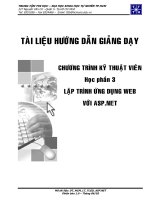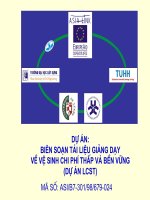Tài liệu giảng dạy CCNA - module 03 chapter 12-OSPF and EIGRP Concepts and Configuration
Bạn đang xem bản rút gọn của tài liệu. Xem và tải ngay bản đầy đủ của tài liệu tại đây (1.23 MB, 95 trang )
1
Module 03 Routing Protocol
Chapter 11
OSPF and EIGRP Concepts and Configuration
2
Objectives
Compare and contrast link-state routing with distance
vector routing
Explain how link-state routing information is maintained
Discuss the link-state routing algorithm
Enable OSPF on a router
Configure a loopback address to set router priority
Change OSPF route preference by modifying the cost
metric
3
Objectives
Describe the differences between EIGRP and IGRP
Describe the key concepts, technologies, and data
structures of EIGRP
Understand EIGRP convergence and the basic operation of
the Diffusing Update Algorithm (DUAL)
Perform a basic EIGRP configuration
Configure EIGRP route summarization
Describe the processes used by EIGRP to build and
maintain routing tables
Verify EIGRP operations
4
LINK-STATE ROUTING PROTOCOL
5
Overview of link-state routing
Protocol Description Characteristics
Distance
vector
RIP v1 and RIP v2
Interrior Gateway
Routing Protocol
(IGRP)
Copies routing table to neighbors
Updates frequently
Slow converge
RIP v1 and RIP v2 use hop count
as metric
View network from neighbors’
perspective
Susceptible to routing loops
Easy to configure and administrate
Consumes a lot of bandwidth
6
Overview of link-state routing
Protocol Description Characteristics
Link-state Open Shortest
Path First (OSPF)
Intermediate-
system to
Intermediate-
system (IS-IS)
Use shortest path
Updates are event triggered
Fast to converge
Send link-state packets to all
network routers
Has common view of network
Not as susceptible to routing loops
Harder to configure
Requires more memory and
processing power than distance
vector
Consumes less bandwidth than
distance vector
7
Link-state routing protocol features
Uses the hello information and Link-state advertisements
(LSAs) it receives from other routers to build a database
about the network
A topological database
Uses the shortest path first (SPF) algorithm (Dijkstra
algorithm) to calculate the shortest route to each network
The resulting SPF tree
Stores this route information in its routing table
8
How routing information is
maintained
When a failure occurs in the network, each link-state router
take flowing action:
Flood LSAs using a special multicast address throughout an
area.
Copy of the LSA and updates its link-state, or topological
database.
Then forward the LSA to all neighboring devices
Recalculate their routing tables.
9
Link-state routing algorithms
They are known collectively as shortest path first (SPF)
protocols.
They maintain a complex database of the network
topology.
They are based on the Dijkstra algorithm.
1
0
SINGLE AREA OSPF CONCEPTS
1
1
OSPF overview
Open Shortest Path First (OSPF) is a link-state routing
protocol based on open standards.
The most recent description is RFC 2328. The Open in OSPF
means that it is open to the public and is non-proprietary.
1
2
OSPF terminology
1
3
OSPF terminology: Links
Token
Ring
Links
An interface on Router.
1
4
OSPF terminology: Link state
The status of a link between two routers.
Neighbors
Token
Ring
Links
1
5
OSPF terminology: Area
A collection of networks and routers that have the same
area identification.
Each router within an area has the same link-state
information.
A router within an area is an “internal” router.
Token
Ring
Area 1
Area 0
1
6
OSPF Areas—Example
Area 0
Area 1
Area 2
Area 3
1
7
OSPF terminology: Link Cost
The value assigned to a link. Rather than hops,
link-state protocols assign a cost to a link that is
based on the speed of the media.
Interface Output Cost.
Neighbors
Token
Ring
Interfaces
Cost = 10
Cost = 6
Cost = 1785
1
8
OSPF terminology: Adjacency
database
A listing of all the neighbors to which a router has
established bi-directional communication. Not every pair of
neighboring routers become adjacent.
Adjacency
database
Neighbors
Token
Ring
1
9
OSPF terminology: Link-state
database
Also known as a topological database.
A list of link-state entries of all other routers in the
internetwork.
Token
Ring
Topological
Database
Adjacency
database
2
0
OSPF terminology: Routing table
The routing table (also known as forwarding database)
generated when an algorithm is run on the link-state
database.
Each router’s routing table is unique
Adjacency
Database
Lists neighbors
Token
Ring
Topological
Database
Lists all routes
Routing
Table
Lists best routes
2
1
OSPF terminology: DR and BDR
router
Designated router (DR) and backup designated router
(BDR):
A router that is elected by all other routers on
the same LAN to represent all the routers.
Each network has a DR and BDR.
Token
Ring
DR
DR
BDR
2
2
Shortest path algorithm
1
4
1 4
2
22
ABC
D
E F G
The best path is the lowest cost path.
2
3
OSPF network types
2
4
OSPF network types: Fourth type
2
5
OSPF Hello Protocol
The rules that govern the exchange of OSPF hello packets
are called the Hello protocol.
Hello packets use : 224.0.0.5 (all routers).
Hello packets are sent at regular intervals (default):
Multi access and Point-to-point: 10s
NBMA : 30s
On multi-access networks the Hello protocol elects a
designated router (DR) and a backup designated router
(BDR).
The hello packet carries information that all neighbors must
agree upon before an adjacency is formed, and link-state
information is exchanged.









